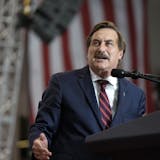"Chia Pets!"
The voice rang out above dozens of others as the near-sellout crowd at Huge Improv Theater scrambled to suggest something nostalgic.
Then members of an improv comedy team stepped up to relate anecdotes and associations the phrase brought to mind — like how the shoulder-pad fashion trend of the 1980s made every woman look like a linebacker.
Ten minutes later, the team and the audience were in the thick of three off-kilter narratives, following a quintet of musically inclined fur trappers; a father intent on watching bizarre VHS tapes with his son; and a quest for the secret of Rob Lowe's eternal youth. By the end of a half-hour, all of those seemingly unrelated stories managed to dovetail into something resembling a satisfying conclusion.
Welcome to the Harold. Or at least, one interpretation of the Harold. It's all part of Huge's "Harold Turns 50" celebration of what's arguably the most important cornerstone of long-form improv.
So what exactly is a Harold? Basically, it's a set of guidelines that help an improv team develop a scene. "The simplest explanation is just three story lines, each visited three times," said Huge co-founder Butch Roy.
You can pick out the familiar beats of the Harold in just about every TV sitcom.
"A group of performers will take an audience suggestion and build on that idea in ways that are unpredictable even to the performers," said Molly Chase, director of House of Whimsy, one of three teams that are performing at Huge every Saturday through the end of October. "There will likely be moments of poignancy and humor, and the whole room — audience and improvisers — are in it together.


